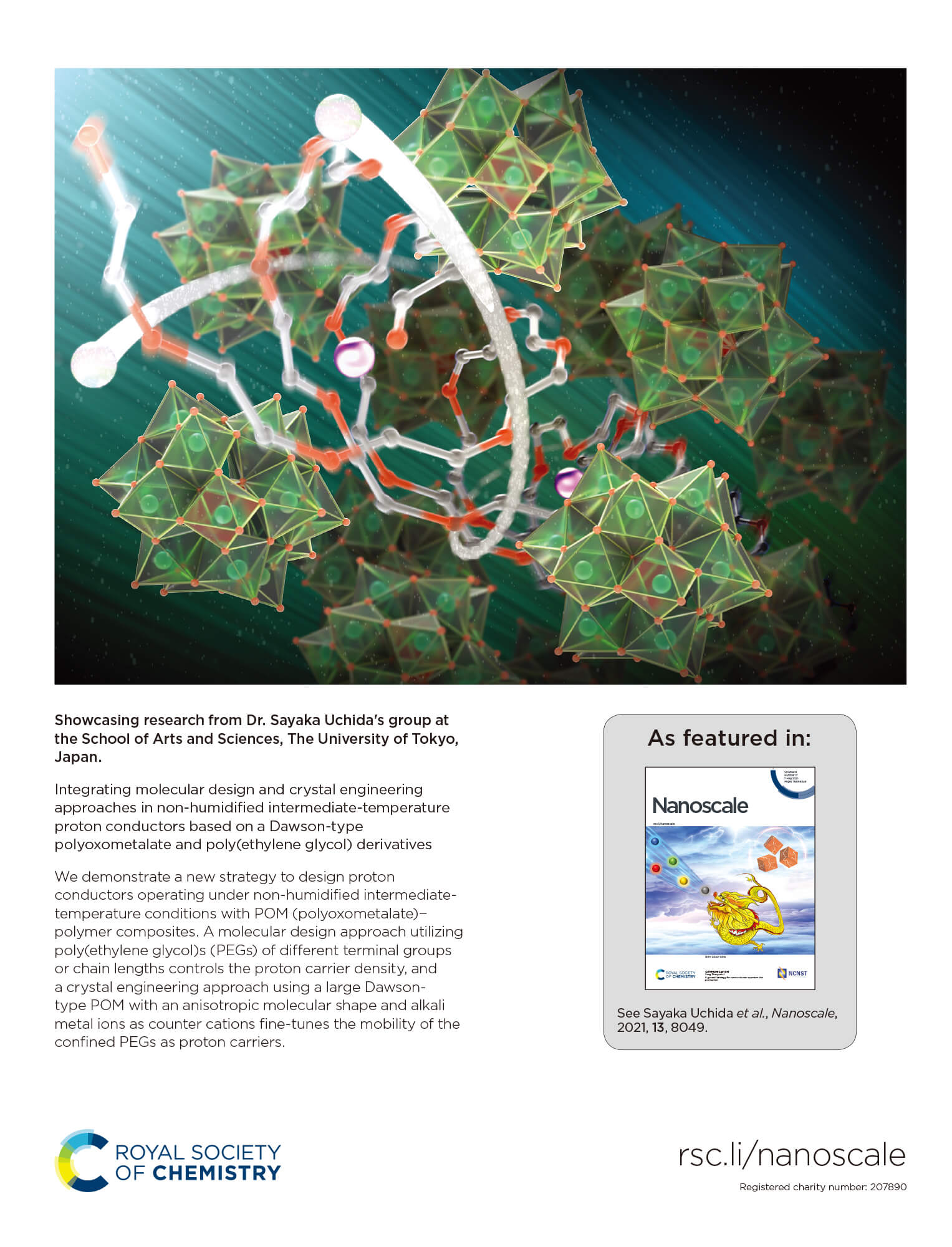論文雑誌「Nanoscale」のカバーピクチャーを制作しました[東京大学]
弊社で制作しました東京大学 内田さやか先生のカバーアートが
イギリスの王立化学会発行の学術雑誌 Nanoscale 2021年5月号に選ばれました。

Client
東京大学
大学院総合文化研究科
内田 さやか 先生
大学院総合文化研究科
内田 さやか 先生
Journal
Nanoscale
Issue 17, 2021, Page 7865 to 8346 Link
Issue 17, 2021, Page 7865 to 8346 Link
Integrating molecular design and crystal engineering approaches in non-humidified intermediate-temperature proton conductors based on a Dawson-type polyoxometalate and poly(ethylene glycol) derivatives
Naoki Ogiwara, Masahiro Tomoda, Shotaro Miyazaki, Zhewei Weng, Hiroshi Takatsu, Hiroshi Kageyama, Toshiyuki Misawa, Takeru Ito and Sayaka Uchida
Anionic metal–oxygen clusters known as polyoxometalates (POMs) have been widely researched as components of proton conductors. While proton conduction under non-humidified intermediate-temperature (100–250 °C) conditions is advantageous from the viewpoint of kinetics, few solid-state materials, not to mention POM-based crystals, show truly effective proton conduction without the aid of water vapor. In this context, non-volatile proton-conductive polymers have been confined into POM-based frameworks, while fast proton conduction was infeasible. Herein, we demonstrate a new strategy to synthesize POM–polymer composites exhibiting fast proton conduction under non-humidified intermediate-temperature conditions. Specifically, a molecular design approach utilizing poly(ethylene glycol)s (PEGs) of different terminal groups or chain lengths controls the proton carrier density, and a crystal engineering approach using a large Dawson-type POM ([α-P2W18O62]6−) with an anisotropic molecular shape and alkali metal ions as counter cations fine-tunes the mobility of the confined PEGs as proton carriers. By integrating these approaches, proton conductivity over 10−4 S cm−1 at 150 °C, comparable to the well-known highly proton-conductive solid-state materials, is achieved. The proton conduction mechanism is discussed with alternative current impedance spectroscopy jointly with specific heat capacity measurements and solid-state NMR spectroscopy.
Link
Naoki Ogiwara, Masahiro Tomoda, Shotaro Miyazaki, Zhewei Weng, Hiroshi Takatsu, Hiroshi Kageyama, Toshiyuki Misawa, Takeru Ito and Sayaka Uchida
Anionic metal–oxygen clusters known as polyoxometalates (POMs) have been widely researched as components of proton conductors. While proton conduction under non-humidified intermediate-temperature (100–250 °C) conditions is advantageous from the viewpoint of kinetics, few solid-state materials, not to mention POM-based crystals, show truly effective proton conduction without the aid of water vapor. In this context, non-volatile proton-conductive polymers have been confined into POM-based frameworks, while fast proton conduction was infeasible. Herein, we demonstrate a new strategy to synthesize POM–polymer composites exhibiting fast proton conduction under non-humidified intermediate-temperature conditions. Specifically, a molecular design approach utilizing poly(ethylene glycol)s (PEGs) of different terminal groups or chain lengths controls the proton carrier density, and a crystal engineering approach using a large Dawson-type POM ([α-P2W18O62]6−) with an anisotropic molecular shape and alkali metal ions as counter cations fine-tunes the mobility of the confined PEGs as proton carriers. By integrating these approaches, proton conductivity over 10−4 S cm−1 at 150 °C, comparable to the well-known highly proton-conductive solid-state materials, is achieved. The proton conduction mechanism is discussed with alternative current impedance spectroscopy jointly with specific heat capacity measurements and solid-state NMR spectroscopy.
Link
